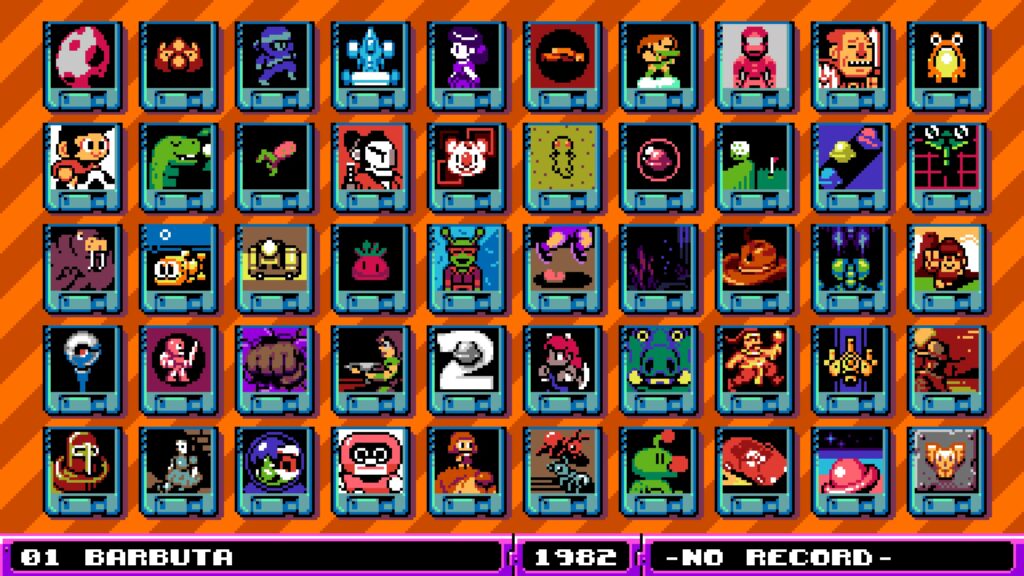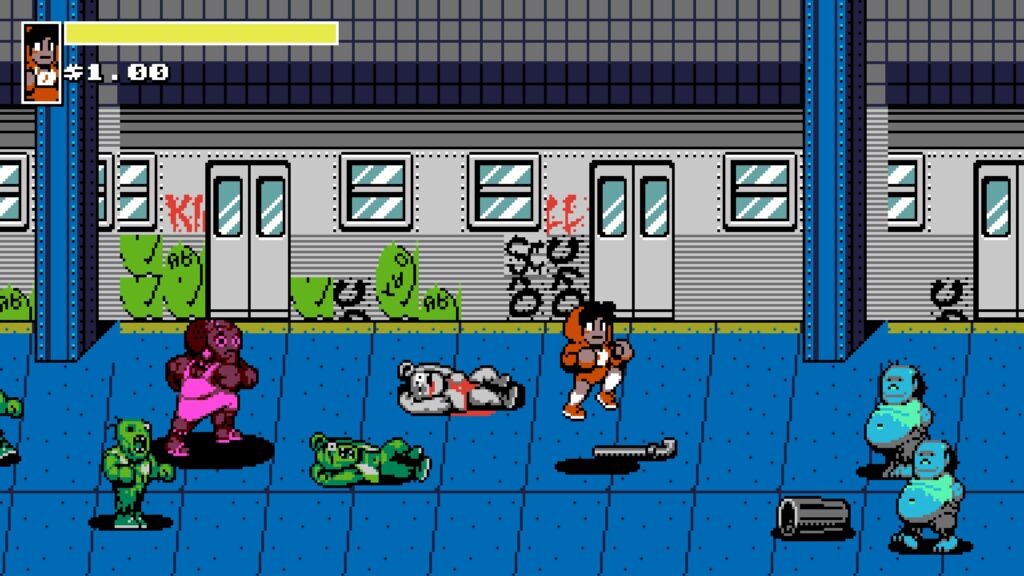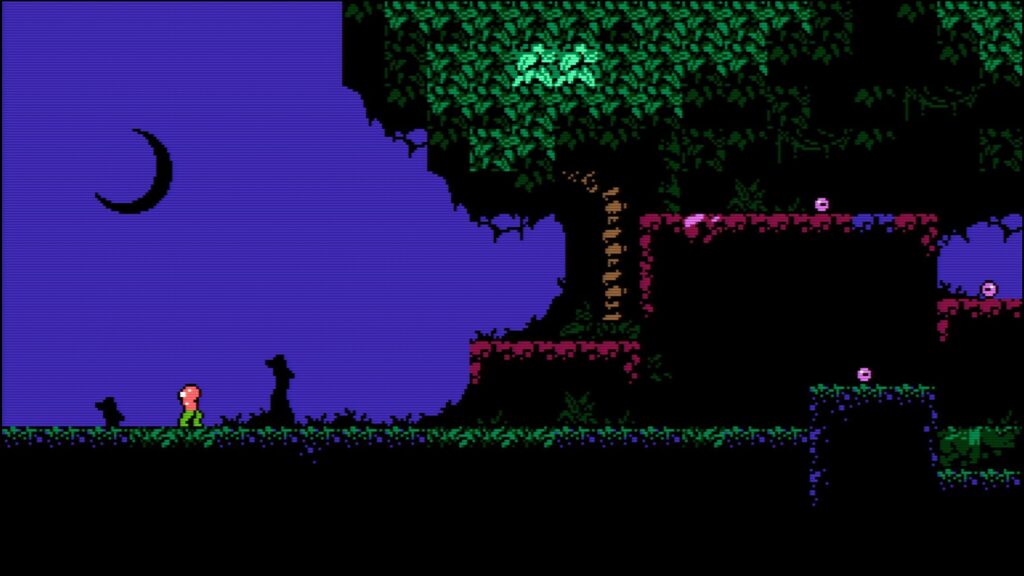Looking back, it’s easy to dismiss games made in the 1980s. The medium was still in its infancy, as clunky and confused as any newborn would be. The graphics were simple, the processors tiny, and the results innovative but rarely impressive. Of course, that wasn’t the fault of the developers. How could anyone make a masterpiece on tech as rudimentary as the Atari 2600 or Nintendo Entertainment System?
This was the question indie developer Mossmouth set out to answer. 38 years after the launch of the NES, they strove to take all the lessons learned over decades of game development and envision what that first era was really capable of. What would an old-school developer do with the knowledge we have now? What kind of wild experiences could they cook up, even with the limitations?
The result is one of the most unique and creative games I’ve played in years. UFO 50 is a cavalcade of innovation and raw game design prowess. Among its collection of 50 titles are experiences that will push and prod at your preconceptions, continually delighting with new ideas and robust takes on the industry’s tried and true formulas. The gameplay is fun and constantly evolving, the graphics are full of personality, and the story that ties it all together is a masterclass in metanarrative design. While not every game is an absolute gem, they don’t really need to be. More than any other, UFO 50 embodies the words “greater than the sum of its parts.”

In 1982, rogue programmer Thorsen Petter develops a video game in secret on the clock of his corporate software company. This title, “Barbuta,” is as archaic as it gets, yet its small flashes of creativity are enough to bring together the disparate developers of their team to form a new entity: LX Systems, which would go on to be known as UFOSoft. With a new console on the market and the game-playing masses to feed, they work together to create titles the likes of which no one has ever seen before.
Now, even that premise requires some reading between the lines. The story of UFO 50 is told almost entirely through context clues, short historical descriptions, and secrets hidden in the code. Very little is directly stated to you, and that’s by design. Everything this game does commits to the bit of being made by a “real” game company in the 1980s, and that means even the menus themselves are framed under that lens. This isn’t a single game made by developer Mossmouth in 2024; this is a collection of 50 classic titles made by UFOSoft in the 80s. You can’t simply look at an in-game wiki or audio log to see the company’s evolving story; you have to figure it out from the games themselves.
This provides the throughline for the core of the experience: 50 unique, fully fledged video games, each with their own premise and ideas to explore. There are platformers, puzzle games, strategy games, action games, racers, shooters, RPGs, and a some you’d never expect to see on NES-level hardware. However, they all remain faithful to the limits of the time: basic color palates, chunky pixel graphics, and no more than two buttons for basic controls.

There are limits in terms of complexity, to be sure, but the tradeoff is the sheer amount of quality content they were able to cram in. This isn’t 50 tech demos disguised as full releases or half-baked concepts that need more time in the oven. With only a few exceptions, these are all multi-hour titles that fully explore their ideas, and some are even large enough to be released as small indie games in their own right. All it takes is a look at the RPGs or action-adventure games to see the proof; these often stretch above 10 hours in length each.
To fully complete UFO 50, finishing each game with the unlockable “gifts” and hidden “cherry” awards, you’d be looking at several hundred hours of gameplay. I committed myself to giving each game a minimum 15 minutes of play, and ended up with over 50 hours total without even trying. I’d highly suggest that anyone interested, regardless of your personal tastes, do something similar. Between the innovative new concepts and rock-solid genre takes, you’ll be surprised by what grabs your attention.
With a complete timeline of entries spanning from 1982 to 1989, this sports not only the complete gambit of genres, but a consistent world displayed entirely through gameplay. As UFOSoft grows and changes as a company, you can see it reflected in each new title. The rise and fall of prominent styles and design ideologies changes the progression of the studio, as well as the evolution of the fictional hardware they’re working with. Over time, a brand identity begins to take shape, and the way it’s shown across the games is very impressive.
The clunky movement controls of 1982s “Barbuta” lead directly to the violent puzzle-platforming of 1984s “Mortol” and eventually the creation of 1985s “MoonCat,” one of the best and most unique games in the entire collection. You’ll see the introduction of ideas and characters that evolve with the company, some growing from background elements to have their own games, as well as the introduction of prominent iconography like life-giving coffee and point-granting cheeseburgers.
It truly feels like a company that’s slowly crafting its legacy over time, a Nintendo that could’ve existed in an alternate reality. This lends a sense of realism and immersion to the game that I’ve never seen done quite this well before. You want to play these 50 games not only because they’re great in their own right, but because you’ve become attached to this fictional company and their unique identity.

This also means that the journey of discovery is excellent, both on a per-game and meta level. The games don’t have manuals or clear guides to follow, and there are many mechanics you’ll have to sus out for yourself as you play. 1985’s bird-based strategy game “Avianos” is downright intimidating when you first see the battle screen, but with a bit of critical thinking, you’ll soon figure things out and dominate the avian kingdom. Aside from a few overly cryptic exceptions, UFO 50 excels at teaching through play and rewarding player curiosity, especially when the reward is another piece of the metanarrative puzzle. Without spoiling anything, there’s a lot happening at UFOSoft behind the scenes, and figuring it all out was a joy as I played.
Of course, with so many games and so much ambition, not everything came out 100% perfect. Strict adherence to ancient console hardware means that some games don’t look as nice or control with the grace of modern titles. I often wished the in-universe “LX” consoles would introduce a controller with four buttons, if only so the more complicated games didn’t have to use weird input combinations to make everything work. There’s a noticeable progression of graphics to go along with the timeline, and while most games look good, a few of the self-imposed limitations can be distracting at times.
But even with those issues, there were only a handful out of all 50 games that I’d say I didn’t like. That’s a pretty great average, and more stand out than I could mention in this review. I highly recommend you play them in chronological order to get the most from the story, but here are a few I especially love:
- Velgress: Climb to the top of the deadly pit Velgress while avoiding a wall of blades that will stop at nothing to kill you! An addicting fast-paced platformer, and the introduction to my favorite recurring character in the collection.
- Night Manor: Try to escape the harrowing Night Manor, unraveling its many rooms while avoiding the resident monster! A point-and-click adventure game without a mouse, combining satisfying puzzles with some novel twists on the genre.
- Elfazar’s Hat: Use your fledgling magic powers to defeat the evil magician holding your animal friends hostage! A top-down shooter with deckbuilding elements, and among the best overall packages in the collection.
- Warptank: Explore the abandoned space station with a machine that can warp from wall to wall! An interesting mix of puzzles, exploration, and platforming with a fun jazzy soundtrack.
- MoonCat: Emerge from the shadows to find answers about what you really are. As stated above, this is among the most creative games in the collection, sporting an excellent moody tone and overflowing with secrets. Without spoiling anything, it redefines how a game character can be controlled.

If one of those didn’t catch your interest, there’s certainly three more that will. At $25 dollars, this is one of the best values you’ll find on Steam, and even more so with one of its frequent sales. It took six developers almost eight years to craft this package, and with directors such as Derek Yu (creator of Spelunky) and Ojiro Fumoto (creator of Downwell), you couldn’t ask for a better team.
The group’s experience regularly shines through the game’s design. Back in the 80s, innovation and experimentation was at the forefront of the industry, but that often came at the cost of refinement. Mossmouth has managed to bring back that creativity while keeping the polish, filling their games with clever design that invisibly provides a more engaging experience.
Game mechanics overlap and interact with each other to grant puzzle-like epiphanies during play, and difficulty curves often peak at the midpoint of a game, providing an excellent dopamine rush as you finally break through to the finale. It’s the type of polish you only see from very seasoned talent, and the fact it’s so prevalent here speaks volumes.

The games also presents a variety of visual and auditory styles. Of course, 8-bit graphics can only be stretched so far, but there’s a lot of effort taken to ensure the 50 don’t feel overly similar or derivative. The soundtrack on offer is very impressive, providing not just quality but a massive quantity of tracks. Over 300 unique tunes were created for the game by composer Erik Surhke, and there are a surprising amount of standouts for such a large selection.
The only legitimate criticisms I have are as I’ve illuded above: overreliance on the past. If the premise of the game is to take classic game design and move it into the modern day, then it makes sense to adhere somewhat to those more classic styles. However, the ways in which it does so feels arbitrary at times. Some games have clear improvements made due to modern game design, while others are held back for seemingly no reason. Why can’t 1984’s adventure game “Planet Zoldath” have more than two item slots, or 1988’s dungeon crawler “Valbrace” have an easily accessible map? Is it because similar classic games didn’t have them? These decisions clash with the otherwise excellent design of the game, creating frustration where it isn’t needed.
Verdict
When looking at the package as a whole, it’s difficult to find fault with UFO 50. I could mention the few games that I personally didn’t like, such as the slow puzzle solving of “Block Koala” or the cryptic RPG design of “Divers,” but that feels unfair when there’s so much high-quality content elsewhere. If you don’t appreciate one title, simply move on to the next. Each new game is like a present waiting to be opened; you could be pleasantly surprised at literally any moment.
I can’t overstate just how impressive this game really is. Creating works of notable quality, even smaller ones such as these, is a significant effort for any team. A few could be enough to establish a studio. But 50? 50 games is absolutely unheard of, especially for a team of only six people. The effort and passion that went into this project was undoubtedly massive, and it shows in every aspect of the end product.
With standout showings in style, music, storytelling, variety, game design, and sheer value for the price, this is an indie classic in the making and an experience I’ll be thinking about for a long while to come. At the end of the day, Mossmouth achieved something I never thought possible: a true NES masterwork.

